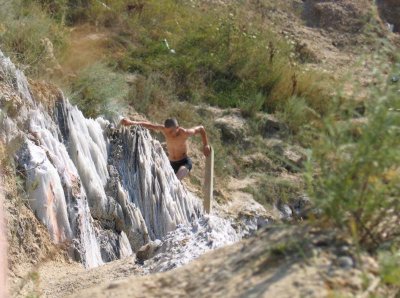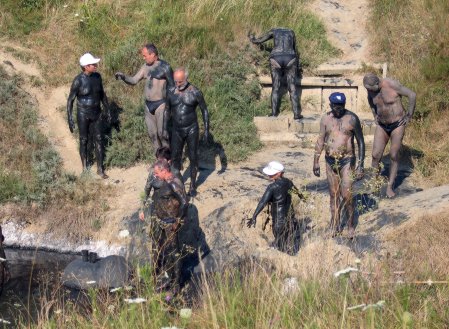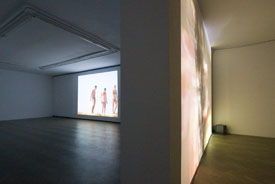KAROL RADZISZEWSKI – Oh!
PAINTER, ARTIST, GUY
Play. The action of the film “Painters” (“Malarze”) takes place in a typical communist-era housing development. A several-story apartment building insulated with a warm layer of Styrofoam. A team of workers are finishing painting the facade. Summer. A scorching day. They work shirtless, go up and down the scaffolding, take a break for a cigarette under the courtyard tree. For refreshment they pour water from the hose over their tanned backs and cropped heads.
A subjective camera, fully zoomed out. Shakily the frame follows particular characters, the lens eye attempts to force its way through the branches to capture another close-up. A gaze typical of a voyeur, covertly steeling looks and catching views, arranging accidental and ordinary gestures into a screenplay with erotic overtones.
Pause. Behind the camera, invisible to the audience is Karol Radziszewski. More or less the same age as the painters working on the scaffolding. A painter himself, only with a diploma from an art school. Founder and publisher of “Dik Fagazine”, the first cultural magazine in Poland for those who “love guys”. Author of video films and photographs, and whose characteristic drawings appear on the walls of apartments, houses, public utility buildings and brand-name lingerie.
Over the past few years the concept of the “Polish painter” has aroused exceptional excitement and admiration. Both as a slogan in colorful magazines, a buzzword thrown around in business conversations, and as concrete images: Wilhelm Sasnal in a Marc Jacobs coat (photo by Jürgen Teller) or Zbyszek Rogalski’s hand photographed by Hedi Slimane. Imperceptibly, after years of total marginalization, the icon of the young artist-painter has joined the pantheon of heroes of Polish culture. The young artist, best veiled in the aura of a brilliant international career – like a writer, actor or musician – can also be Someone. A public figure.
From the outside it doesn’t have to look so dignified. A Polish painter is also someone who renovates apartments- cheaply and reliably, who works on construction sites in England or Germany, “a Polish plumber” specializing in a somewhat different field. This semantic capacity of the word “painter” has been aptly emphasized recently by Rafał Bujnowski, an artist, whose figure shows up not only on the pages of magazines but also on scaffoldings – let’s recall the most popular of a series of similar works – Bujnowski’s renovation of the façade of the Bunkier Sztuki in Kraków (2001).
Play. The apartment house is now a rich pink color. At first glance it resembles the color used by Bujnowski, although that one was apricot. However, there is an association, the situation is similar: young men on scaffolding slowly cover the wall with a fresh coat of paint. Shot slightly in slow motion, their motions become refined and form a peculiar, somewhat sensual choreography. The camera traces the work of their muscles, body and the details of their clothing. One of the painters is wearing a peaked cap, very similar to the one usually worn by Karol Radziszewski. Another painter goes up onto the roof and strolls over it against a hot, blue sky.
Pause. The painter as an object of desire? In our specifically Polish culture this desire has been so far unilateral, not necessarily purely erotic in nature. It has been associated with youth, success and fame, but more with a name and its social status than with a concrete body. Although undoubtedly, an artist, like any other human being, can also be treated as a sexual object, can be the object of fantasies, or can even see to it that these are fulfilled. The sexuality of artists, for example, painters – young, attractive men – is not however, the subject of public debate. Through “Dik Fagazine”, Radziszewski introduces a significant change in this area. The sixth edition of the magazine (2007) was completely dedicated to Polish artists: “White, heterosexual men (some even married, some even have children). ARTISTS.” Willingly posing for photographs and sharing – often intimate- details about their “private” lives, the artists just the same firmly defend their heterosexual identity. “I think that not everything is erotic – though,” says Oskar Dawicki. Here we are dealing with an outlook that exceeds the Polish norm in two ways: the erotic gaze of a voyeur, questioning the sexual indifference of an artist, and the affable look of a gay.
Play. Painters on scaffolding, painters outside the apartment building. At times, the window’s edge enters the frame, when the camera strives to capture a better shot of another character. A different type of desire, one might say- innocent – purely erotic. The voyeur’s eye watches the anonymous group of workers, and our imagination adds the spicy associations with PAINTERS. Radziszewski almost ostentatiously directs the camera outside the area of attractions sanctioned by the local culture, and instead of young, talented and successful ARTISTS he spies on GUYS with exposed torsos sitting on the scaffolding of the neighboring apartment building. Like a typical voyeur, he draws unmediated satisfaction from what he will see but also from the fact, that the view he reveals is not characteristic of how one sees in the local culture. In this way, the act of erotic affirmation, incorporated into Karol’s artistic view, shows its constructive, culture-forming role.
Łukasz Gorczyca
Curator: Monika SzewczykKarol Radziszewski

PLAN YOUR VISIT
Opening times:
Thuesday – Sunday
10:00-18:00
Last admission
to exhibition is at:
17.30


